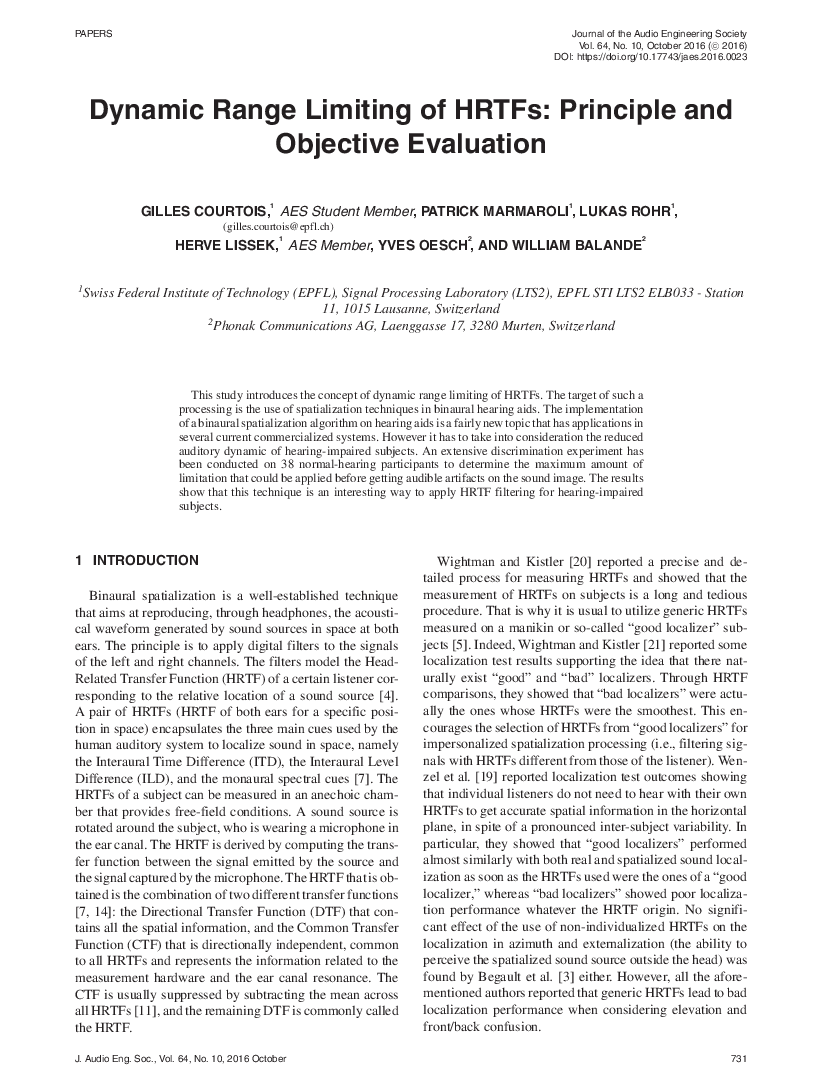Home / Publications / E-library page
You are currently logged in as an
Institutional Subscriber.
If you would like to logout,
please click on the button below.
Home / Publications / E-library page
Only AES members and Institutional Journal Subscribers can download
This research addresses the challenge of incorporating dynamic range limiting of the magnitude response of HRTFs for hearing-impaired listeners who are using binaural hearing aids. In this application, a direct implementation of spatialization using the original HRTFs may pose a problem if some frequency areas are moved above the pain threshold or below the hearing threshold for hearing-impaired listeners. An extensive discrimination experiment was conducted with 38 normal-hearing participants to determine the maximum amount of limitation that could be applied before audible artifacts degraded the sound image. The experiment helped to determine the maximum limitation that can be applied so that at least half of the normal-hearing tested subjects cannot distinguish between the original and limited version of the spatial filters used. Although wide-dynamic range compression (WDRC) at the output of the hearing aids can produce benefits, pre-processing the HRTFs is preferable to limit its effect on the frequency spectrum and loudness. The objective is to optimize the HRTFs to diminish the risk that they are distorted by the WDRC processing in a crucial part of the sound spectrum.
Author (s): Courtois, Gilles; Marmaroli, Patrick; Rohr, Lukas; Lissek, Hervé; Oesch, Yves; Balande, William
Affiliation:
Swiss Federal Institute of Technology (EPFL), Signal Processing Laboratory (LTS2), Lausanne, Switzerland; Phonak Communications AG, Murten, Switzerland
(See document for exact affiliation information.)
Publication Date:
2016-10-06
Import into BibTeX
Permalink: https://aes2.org/publications/elibrary-page/?id=18515
(275KB)
Click to purchase paper as a non-member or login as an AES member. If your company or school subscribes to the E-Library then switch to the institutional version. If you are not an AES member Join the AES. If you need to check your member status, login to the Member Portal.

Courtois, Gilles; Marmaroli, Patrick; Rohr, Lukas; Lissek, Hervé; Oesch, Yves; Balande, William; 2016; Dynamic Range Limiting of HRTFs: Principle and Objective evaluation [PDF]; Swiss Federal Institute of Technology (EPFL), Signal Processing Laboratory (LTS2), Lausanne, Switzerland; Phonak Communications AG, Murten, Switzerland; Paper ; Available from: https://aes2.org/publications/elibrary-page/?id=18515
Courtois, Gilles; Marmaroli, Patrick; Rohr, Lukas; Lissek, Hervé; Oesch, Yves; Balande, William; Dynamic Range Limiting of HRTFs: Principle and Objective evaluation [PDF]; Swiss Federal Institute of Technology (EPFL), Signal Processing Laboratory (LTS2), Lausanne, Switzerland; Phonak Communications AG, Murten, Switzerland; Paper ; 2016 Available: https://aes2.org/publications/elibrary-page/?id=18515
@article{courtois2016dynamic,
author={courtois gilles and marmaroli patrick and rohr lukas and lissek hervé and oesch yves and balande william},
journal={journal of the audio engineering society},
title={dynamic range limiting of hrtfs: principle and objective evaluation},
year={2016},
volume={64},
issue={10},
pages={731-739},
month={october},}
TY – paper
TI – Dynamic Range Limiting of HRTFs: Principle and Objective evaluation
SP – 731 EP – 739
AU – Courtois, Gilles
AU – Marmaroli, Patrick
AU – Rohr, Lukas
AU – Lissek, Hervé
AU – Oesch, Yves
AU – Balande, William
PY – 2016
JO – Journal of the Audio Engineering Society
VO – 64
IS – 10
Y1 – October 2016